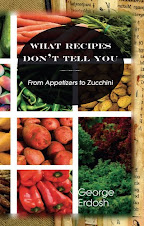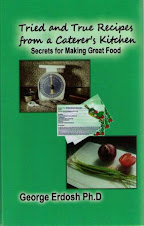Cilantro

Monday, August 19, 2013
LET'S HAVE A GOOD STEAK!
Not counting vegetarians, I haven’t met many people
who don’t love a good steak. Because of this love affair, many steak-sized not
too tender meats in the supermarket meat section are labeled “steaks,” such as
beef chuck steak, chuck tender steak, round steak and chuck eye steak. Even
some pork chops are deliberately mislabeled as “steak.”
I love a good steak like any meat lover yet I gave
up on cooking it. Why? I cannot match the flavor and tenderness of the meat
served in a good steak-house. My steaks are not fork-tender and just mediocre
in flavor.
For a good steak the grade of the meat is of prime
importance. The USDA started grading beef in 1927 and ever since every piece of
beef is graded according to their system.
The highest grade steak, Prime, is well marbled
throughout. The next grade is Choice with less marbling and that’s the highest grade
you find in most supermarkets. Select grade has even less marbling and the
lowest, Standard is a meat red all the way through without the marbling fat.
Only the edges contain fat, not enough to lubricate the meat. A tough piece of
meat. Note that some supermarkets use their own grading system though Prime and
Choice are standard for all.
So for a good home-grilled steak, go for Prime.
But you won’t find this grade in just any meat counter. Prime grade is
expensive and often reserved by high-end butchers, exclusive clubs and
restaurants for customers and clients who have generous expense accounts or
far-reaching credit cards.
Yet we all had affordable steaks in steak-houses.
How do they do it? By meticulous tenderizing lower-grade Choice meat. They do
this by either chemical tenderizers (and these are all blends of natural
products such as papaya, fig and pineapple) or by passing the meat through
mechanical tenderizers which are like medieval torture instruments with many
sharp needles that break up the tough meat fibers.
But grade is not the only thing you need to
consider. A good steak needs to be aged too. Raw, unaged beef has a metallic
taste and is rather tough, chewy; aging improves both flavor and tenderness. It
chemically alters flavor and softens tough connective tissues. During the aging
process the meat shrinks and loses some 12 to 15 percent moisture. The process adds
to the price as the meat must rest in a temperature-humidity controlled room
for about 15 days, for real high quality meat up to six weeks. Plus you pay for
the shrinkage too.
Most shoppers are very conscious of the price of
the meat package, and meat processors need to consider how much extra they can
charge for the aging before they lose buyers.
When I want a good steak, I choose a steak house.
Saturday, July 27, 2013
BBQ: CHARCOAL OR GAS?
Dedicated barbeque cooks mostly believe in hot
charcoal, not gas-heated grills. They claim the flavor of the grilled food is
better. Unless you have both and taste test grilled foods prepared on both,
it’s impossible to know for certain.
I grill my foods on charcoal and have done it so
for many decades. Yet if you like grilling and your cooking time is limited,
there is nothing like turning on the propane heat which heats up in minutes. My
charcoal, backed by many years of experience, heats up to very hot in about
twenty minutes. I never use charcoal lighting fluid or instant charcoal that
had been soaked in some chemical for quick fire. Nor the traditional chimney starter. And I don’t use the true
charcoal made from wood that I found unpredictable. Plain, inexpensive briquettes work fine
for me.
Since I live in a forested area, I use two pine
cones or dry twigs to start the fire, both readily available. After removing the grill rack that
holds the charcoal (I use two double-hooked wire made from two coat hangers), I
light the cone or twig fire and when burning fiercely, I reposition the grill
rack using my wire hooks, piling the briquettes over the fire. Having alively
fire under them, they catch quickly and in no time they glow red.
Grilling outdoors is fun and eating the grilled
food comes as a second enjoyment. Plus cleanup work is minimal (I never bother
cleaning my grill unless charred food accumulation gets too thick—with the
intense heat it remains perfectly safe).
Whether I grill meat, poultry or fish, I often add
a few other foods to grill: thick rounds of eggplants, thick slabs of summer
squash, thick slices of partially cooked unpeeled potatoes to name a few, all
generously oiled to promote browning and prevent sticking. On a hot fire sausage,
one-serving pieces of marinated meat or boneless poultry takes no more than
three or four minutes per side. Fish less, two to two-and-half minutes.
Vegetables take about the same, three to five minutes each side.
I haven’t found that using two-stage fire (one
side hotter than the other) has any benefit—it’s just another unnecessary step.
Tuesday, July 16, 2013
GAME MEAT - FORK TENDER WITHOUT GAMEY FLAVOR
If you are a hunter, read the first half only; if a
cook, read the second half. Only those hunters who cook their game need to read
from top to bottom.
Few people enjoy game meat, complaining that the
flavor is too gamey and the meat is too tough. Blame both the hunter and the
cook. Game meat can be as free of gamey flavor as good ranch-raised beef and
nearly as tender. Let’s start with the hunter.
The
Hunter’s Job
A frightened animal releases adrenaline that
tightens its muscles; tight muscles mean tougher meat. Good hunters have
stealth, patience, and skill to take their game unaware and not frightened.
After a successful shot, drain the blood right away, remove testicles and
scrotum from males before they can release hormones that taint the flavor of
the meat. Gut the carcass quickly and don’t delay transporting meat any longer
than necessary.
Hunters who want to save money and process their
own game meat are fools. Meat processing is an art and science that butchers
spend years learning. The cost of the butcher’s work pays for itself in the
long run.
All meat benefit from aging and game is no
exception — aging improves flavor, relaxes muscles and tenderizes fibers.
Unaged wild meat is still good, but aged meat turns more tender and more
flavorful after about five days under controlled temperature and humidity. Very
few have the proper place to age meat, again, leave it to the butcher.
Aging means moisture loss, so expect 10 to 12
percent less meat after proper aging, yet the flavor will be more concentrated.
Packaging the meat for long-term storage is as
important as processing and aging. Poorly-packaged meat turns rancid when
exposed to oxygen in the air that finds its way into the package. It also
develops “freezer burns.” The cause of freezer burn is simply dehydration, loss
of moisture and oxidation. In a properly wrapped package freezer burn doesn’t
exist.
How you freeze meat and how fast you freeze it are
both critical to retaining high quality and full moisture content, and only
quick freezing in the butcher’s very cold deep freezer with fans running can
achieve that. Leave both packaging and freezing to your butcher.
The Cook’s
Job
When you want a frozen game meat ready for a meal,
plan ahead. Defrost it slowly in the refrigerator for the least moisture loss,
never on your counter (bad), under running water (worse) or in a microwave
(worst). Thick steaks defrost in a day or two, roasts in three to four days, a
little longer if the inside of your refrigerator looks like a commuter bus in
rush-hour.
Wild game is not like corn-fed beef. Most wild
game develop little fat reserves (except bear in the fall). Expect lean meat —
in fact, so lean that it can be much too dry if you don’t cook it right. If the
hunter bagged on old animal, it is likely to be tough, too.
First, let’s get rid of the strong gamey flavor
that comes mainly from the fat covering, whatever little there is. Trim off all
visible fat as much as possible and you get rid of most of that objectionable
flavor. But you end up with even leaner meat.
Any cooking method that uses oil adds lubricant to
the meat and makes it more tender. Long, slow cooking at bare simmer is the
best, such as stewing, braising or pot roasting. If you chose dry-heat cooking,
such as broiling or grilling on coal, use either tenderizer or an acidic
marinade for at least four hours before cooking. A splash of dry red wine is
very nice with wild meat, either in the marinade or in the liquids of
slow-cooking methods.
Tuesday, July 9, 2013
NATURALLY FERMENTD SUMMER PICKLES
As soon as the first fresh-picked pickling
cucumbers appeared at the farmers’ market, my mother was ready with her jar,
dill weed, garlic and pickling salt. Naturally fermented summer pickles are
hard to beat for flavor. They are ready to start fermentation after only ten
minutes of preparation and are ready to eat in five days. As kids, we could
hardly wait until my mother pronounced them finished and edible.
Now I follow my mother’s tradition, and during the
summer season it’s rare for us not to have either a jarful in the fridge or one
on the counter where natural bacteria and yeast are working diligently to
ferment the cucumbers. It’s hard to believe that with such little work you can
produce such good pickles in your own kitchen.
Purchase pickling cucumbers as small and as fresh
as you can. If only larger ones are available, splitting them lengthwise not
quite to the other end also works. You don’t have to use pickling salt, but it
works better as chemicals added to table salt tend to cloud the liquid. Fresh
dill weed is not always easy to find, but if all else fails, I use dried dill
weed and dill seed.
The concentration of salt is critical. Two bacilli (Lactobacillus and Leuconostoc) produce lactic acid (same as in
yogurt), which ferments and softens the cucumbers, and yeast from the air produce
the flavor. Both bacteria and
yeast tolerate a certain salt level that also inhibits the growth of other undesirable
creatures. It is necessary to measure the water and salt carefully so nothing
can go wrong.
The ideal fermentation temperature is 68 degrees.
Pickling will still occur within a range of five degrees cooler or warmer.
Below 50 degrees fermentation is slow, above 80 degrees cucumbers ferment too
fast and are likely to turn soft and mushy.
Naturally Fermented Summer Pickles
2 lb (about 2 quarts) firm, fresh, unblemished pickling
cucumbers, preferably not much larger than your thumb
3 cloves garlic, peeled and crushed
3 sprigs fresh dill OR 3 fresh heads of dill weed
2 to 4 hot chilies, fresh or dried, slit on one
side
2 Tbsp pickling (canning) salt
4 cups water
1 Tbsp dill seeds
1 Tbsp pickling spice
- Wash cucumbers thoroughly. If large, slice each to within ½ inch of other end along its length.
- Place garlic, dill, and chilies into a two-quart glass jar or crockery pot. Slip cucumbers into the jar so they stand up side by side (like people in an elevator in rush hour). Add dill seeds and pickling spice.
- Heat water until lukewarm, add pickling salt and stir until dissolved. Pour over cucumbers until they are totally submerged.
- Cover with a cheesecloth, note the date started on a label and let ferment at room temperature.
Scrape off any scum that forms on top of the
liquid. The cucumbers turn translucent and mildly tart with a pleasing fermented
scent in three to five days. Start checking pickles after three days—continue
testing flavor and texture daily. As soon as they are sour enough to suit your
taste but still crisp, cover the jar with a lid and refrigerate.
Pickles stay firm in the refrigerator for three to
four weeks but over the seeks they tend to get more sour.
Thursday, July 4, 2013
Corn-on-the-Cob: BBQ grill or boil?
Should I throw my corn on the hot grill (since it’s
already hot anyway) or boil in salted water? In my mind no question remains:
boil. We have superb table corn in our area and during corn season we OD on
corn, have them three or four times a week. I am an expert on corn cooking.
Reasonable young corn cooks in salted boiling
water for exactly four minutes, same as soft-boiled eggs. You never should
overcook corn, it toughens it. Microwave is also a death to it.
One day we were attending a backyard barbecue
party. The host cut absolutely fresh, young corn from his luscious garden in
the back and gave them to his non-cook wife. I was horrified to see her cooking
them in the microwave. Sure enough, they turned tough as beef jerky and virtually
inedible.
When grilling corn you lose cooking control. How
much time on the grill provides tender, succulent corn? It’s impossible to say as heat of the grill varies.
I had many overcooked corn off the grill from friends party but do not remember
perfectly cooked ears.
In boiling water nothing can go wrong: drop them
in briskly boiling water, set the timer for four (but no more than five)
minutes and lift them out with a pair of tongs when the timer buzzes. You’ll
have perfect corn every time. All it needs is salt and for many, butter.
Subscribe to:
Comments (Atom)








 Stumble It!
Stumble It!










